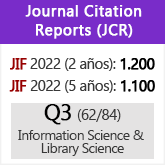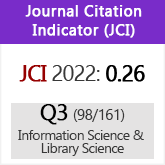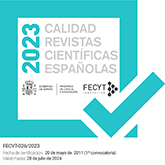Evaluación del rendimiento de los sistemas de búsqueda de respuestas de dominio general
DOI:
https://doi.org/10.3989/redc.2013.2.921Palabras clave:
Recuperación de información, sistemas de búsqueda de respuestas, evaluación, medidas de evaluación, World Wide WebResumen
Los sistemas de búsqueda de respuestas (SBR) son una alternativa a los tradicionales sistemas de recuperación de información tratando de ofrecer respuestas precisas y comprensibles a preguntas factuales, en lugar de presentar al usuario una lista de documentos relacionados con su búsqueda. Se ha evaluado la eficacia de cuatro SBR disponibles en la Web —QuALiM, SEMOTE, START, y TrueKnowledge—, mediante una amplia muestra de preguntas de definición, factuales y de lista, pertenecientes a distintos dominios temáticos. Se utilizó una colección de 500 preguntas cuyas respuestas fueron valoradas por los usuarios y, posteriormente, se aplicaron varias medidas para su evaluación (MRR, TRR, FHS, MAP y precisión). Se observa que START y TrueKnowledge presentan un nivel aceptable de respuestas correctas, precisas y en una secuencia bien ordenada. Los resultados obtenidos revelan el potencial de esta clase de herramientas en el ámbito del acceso y la recuperación de información de dominio general.
Descargas
Citas
Abdou, S.; Savoy, J.; Ruch, P. (2006). Dépister efficacement de l’information dans une banque documentaire: L’exemple de MEDLINE. En: Actes du XXIVème Congrès INFORSID. 129-143.
Belkin, N.J.; Vickery, A. (1985). Interaction in Information Systems: A Review of Research from Document Retrieval to Knowledge-based systems (LIR Report No 35). The British Library: Londres.
Blair-Goldensohn, S.; McKeown, K.; Schlaikjer, A. H. (2004). Answering Definitional Questions: A Hybrid Approach. En: Maybury, M. T. (ed.), New Directions in Question Answering. AAAI Press: Palo Alto. 47-58.
Buckley, C.; Voorhees, E. M. (2000). Evaluating evaluation measure stability. IGIR ‘00 Proceedings of the 23rd annual international ACM SIGIR conference on Research and development in information retrieval. 33-40. http://dx.doi.org/10.1145/345508.345543
Cleverdon, C. (1997). The Cranfield tests on index languages devices. En: Sparck Jones, K.; Willett, P. (eds.), Readings in information retrieval. Morgan Kaufmann: San Francisco. 47-59.
Cui, H.; Kan, M. Y.; Cua, T. S.; Xiao, J. (2004). A Comparative Study on Sentence Retrieval for Definitional Question Answering. SIGIR Workshop on Information retrieval for Question Answering (IR4QA).
Crouch, D.; Saurí, R.; Fowler, A. (2005). AQUAINT Pilot Knowledge-Based Evaluation: Annotation Guidelines: Palo Alto Research Center. Disponible en: http://www2.parc.com/isl/groups/nltt/papers/aquaint_kb_pilot_evaluation_guide.pdf.
Fukumoto, J.; Kato, T.; Masui, F. (2004). Question Answering Challenge (QAC-1) an evaluation of question answering tasks at the NTCIRWorkshop 3. Proceedings of AAAI Spring Symposium on New Directions in Question Answering. 122-133.
Green, B. F.; Wolf, A. K.; Chomsky, C.; Laughery, K. (1961). Baseball: An Automatic Question Answerer. Proceedings of the Western Joint Computer Conference. v.19, pp. 219–224.
Greenwood, M. A.; Saggion, H. (2004). A Pattern Based Approach to Answering Factoid, List and Definition Questions. Proceedings of the 7th RIAO Conference (RIAO 2004). 232-243.
Harman, D. K. (1998). Text retrieval conferences (TRECs): providing a test-bed for information retrieval systems. Bulletin of the American Society for Information Science, 24 (4), pp. 11-13. http://dx.doi.org/10.1002/bult.90
Jackson, P.; Schilder, F. (2005). Natural Language Processing: Overview. En: Brown, (ed.), Encyclopedia of Language & Linguistics, 2. Elsevier Press: Amsterdam. 503-518.
Kaisser, M. (2008). The QuALiM question answering demo: supplementing answers with paragraphs drawn from Wikipedia. Proceedings of the 46th Annual Meeting of the Association for Computational Linguistics on Human Language Technologies: Demo Session. Stroudsburg: Association for Computational Linguistics. 32–35.
Kangavari, M. R.; Ghandchi, S.; Golpour, M. (2008). A New Model for Question Answering Systems. World Academy of Science, Engineering and Technology, 42, pp. 506-513.
Katz, B.; Borchardt, G.; Felshin, S.; Shen, Y.; Zaccak, G. (2007). Answering English questions using foreign-language, semistructured sources. Proceedings of the First IEEE International Conference on Semantic Computing (ICSC 2007). Irvine: IEEE Computer Society. 439-445. http://dx.doi.org/10.1109/ICSC.2007.59
Kolomityets, O.; Moens, M. F. (2011). A Survey on Question Answering Technology from an Information Retrieval Perspective. Information Sciences (en prensa). http://dx.doi.org/10.1016/j.ins.2011.07.047
Olvera-Lobo, M. D.; Gutiérrez-Artacho, J. (2010). Question-Answering Systems as Efficient Sources of Terminological Information: Evaluation. Health Information and Library Journal, 27 (4), pp. 268-276. http://dx.doi.org/10.1111/j.1471-1842.2010.00896.x PMid:21050369
Olvera-Lobo, M. D.; Gutiérrez-Artacho, J. (2011a). Evaluation of Open -vs. Restricted- Domain Question Answering Systems in the Biomedical Field. Journal of Information Science, 37 (2), pp. 152-162. http://dx.doi.org/10.1177/0165551511398575
Olvera-Lobo, M. D.; Gutiérrez-Artacho, J. (2011b). Language resources used in multi-lingual Question Answering Systems. Online Information Review, 35 (4), pp. 543-557. http://dx.doi.org/10.1108/14684521111161927
Olvera-Lobo, M. D.; Gutiérrez-Artacho, J. (2011c). Multilingual Question-Answering System in Biomedical Domain on the Web: An Evaluation. Multilingual and Multimodal Information Access Evaluation, Lecture Notes in Computer Science, vol. 6941, pp. 83-88. http://dx.doi.org/10.1007/978-3-642-23708-9_10
Pérez-Coutiño, M.; Solorio, T.; Montes y Gómez, M.; López López, A.; Villaseñor Pineda, L. (2004). The Use of Lexical Context in Question Answering for Spanish. Workshop of the Cross-Language Evaluation Forum (CLEF 2004). pp.377-384, http://www.clef-campaign.org/2004/working_notes/CLEF2004WN-Contents.html [11 octubre 2011].
Peters, C. (2009). What Happened in CLEF 2009: Introduction to the Working Notes. Working Notes for the CLEF 2009 Workshop. http://www.clef-campaign.org/2009/working_notes/ [11 septiembre 2011].
Radev, D. R.; Qi, H.; Wu, H.; Fan, W. (2001). Evaluating Web-based Question Answering Systems. Informe técnico. University of Michigan.
Rodrigo, A.; Pérez-Iglesias, J.; Peñas, A.; Garrido, G.; Araujo, L. (2010). A Question Answering System based on Information Retrieval and Validation. Notebook Papers/LABs/Workshops (CLEF 2010). http://clef2010.org/index.php?page=pages/proceedings.php [5 septiembre 2011].
Salton, G.; McGill, J. (1983). Introduction to modern information retrieval. New York: McGraw-Hill.
Sultan, M. (2006). Multiple Choice Question Answering. Sheffield: University of Sheffield. Tesis doctoral.
Tsur, O. (2003). Definitional Question-Answering Using Trainable Text Classifiers. University of Amsterdam: Amsterdam. Tesis doctoral.
Voorhees, E. M. (1999). The TREC 8 Question Answering Track Report. Proceedings of the 8th Text Retrieval Conference. http://trec.nist.gov/pubs/trec8/papers/qa_report.pdf.
Voorhees, E. M. (2002). Overview of the TREC 2002 Question Answering Track. Proceedings of the Eleventh Text Retrieval Conference. http://comminfo.rutgers.edu/~muresan/IR/TREC/Proceedings/t11_proceedings/t11_proceedings.html [5 septiembre 2011].
Voorhees, E. M.; Tice, D. (1999). The TREC-8 question answering track evaluation. En: Voorhees, E. M.; Harman, D. Proceedings of the Eleventh Text Retrieval Conference. Gaithersburg, MD: NIST Publicación Especial. http://comminfo.rutgers.edu/~muresan/IR/TREC/Proceedings/t8_proceedings/t8_proceedings.html [5 septiembre 2011].
Warren, D. (1981). Efficient Processing of Interactive Relational Database Queries Expressed in Logic. Proceedings Seventh International Conference on Very Large Data Bases. Cannes: VLDB Endowment. v.7, pp. 272-283.
Weizenbaum, J. (1966). Eliza: A computer program for the study of natural language communication between man and machine. Communications of the ACM, 9 (1), pp. 36-45. http://dx.doi.org/10.1145/365153.365168
Woods, W. A.; Kaplan, R. M.; Nash-Webber, B. (1972). The Lunar Sciences Natural Language Information System. En: BBN Final Report 2378. Cambridge: Bolt, Beranek and Newman.
Zweigenbaum, P. (2005). Question answering in biomedicine. Proceedings Workshop on Natural Language Processing for answering. Budapest: ACL, EACL 2003. 1-4.
Publicado
Cómo citar
Número
Sección
Licencia
Derechos de autor 2013 Consejo Superior de Investigaciones Científicas (CSIC)

Esta obra está bajo una licencia internacional Creative Commons Atribución 4.0.
© CSIC. Los originales publicados en las ediciones impresa y electrónica de esta Revista son propiedad del Consejo Superior de Investigaciones Científicas, siendo necesario citar la procedencia en cualquier reproducción parcial o total.Salvo indicación contraria, todos los contenidos de la edición electrónica se distribuyen bajo una licencia de uso y distribución “Creative Commons Reconocimiento 4.0 Internacional ” (CC BY 4.0). Puede consultar desde aquí la versión informativa y el texto legal de la licencia. Esta circunstancia ha de hacerse constar expresamente de esta forma cuando sea necesario.
No se autoriza el depósito en repositorios, páginas web personales o similares de cualquier otra versión distinta a la publicada por el editor.

















